If you’re stuck between OpenCart vs BigCommerce, you’re not alone. Both platforms are popular, powerful, and come with distinct pros and cons. But which one truly fits your business needs?
In this article, we’ll walk you through a side-by-side comparison of OpenCart and BigCommerce, covering these key aspects:
- Pricing;
- Ease of use;
- Themes & customization;
- eCommerce features;
- SEO & marketing tools;
- Apps & integration;
- Security & compliance;
- Customer support.
Keep reading for more details!
OpenCart vs BigCommerce: A Quick Glance
OpenCart is a free, open-source eCommerce platform that lets you build and manage an online store on your own hosting. What makes OpenCart stand out is its lightweight nature and flexibility. It doesn’t demand heavy server resources, so it’s quick to install and easy to run even on modest hosting plans. Since its launch in 2008, this simplicity has helped OpenCart attract over 200,000 merchants worldwide.
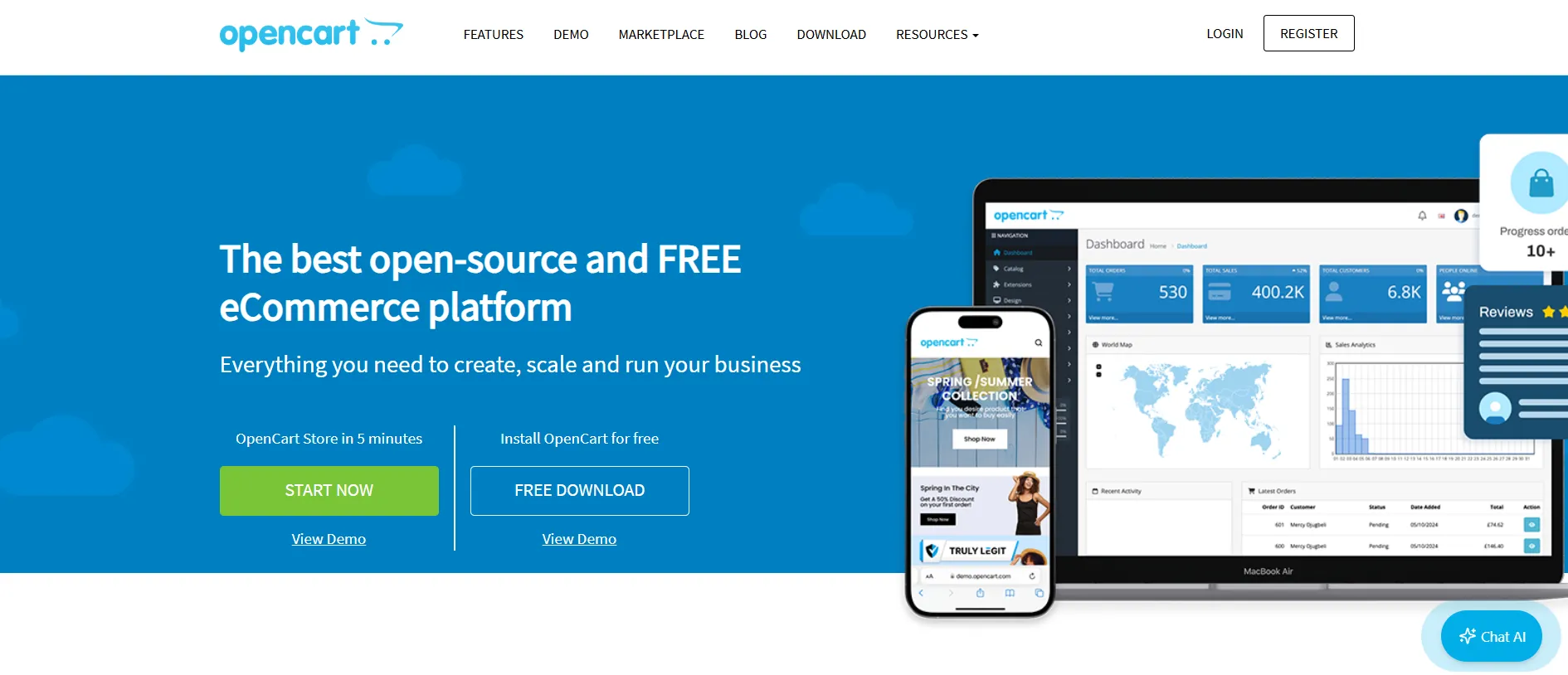
In contrast, BigCommerce is a cloud-based eCommerce platform that powers over 40,000 websites worldwide. The platform takes care of the technical side for you, including hosting, security, and updates. It’s built to handle high-volume sales and complex product catalogs, with high flexibility through APIs for custom integrations.

In 2025, BigCommerce, BundleB2B, and Feedonomics officially unified under the new brand Commerce.com. This move reflects their shared mission to offer a complete commerce platform that supports both B2B and B2C merchants at scale, all under one powerful ecosystem.
Now that we’ve introduced both platforms, let’s take a closer look at how BigCommerce vs OpenCart compare in terms of advantages and limitations:
Platform | OpenCart | BigCommerce |
Pros |
|
|
Cons |
|
|
To help you decide which platform aligns best with your needs, we’ll now explore how OpenCart vs BigCommerce compare across each core aspect of running an online store.
Pricing
The Verdict
When comparing OpenCart vs BigCommerce in terms of cost, OpenCart wins if you have the technical skills to manage it. Its open-source nature gives you full control over costs, and you can run a functional store at a much lower price than BigCommerce's monthly fees.
OpenCart pricing
Although OpenCart is open-source and free to download, running a store still involves additional costs, like hosting, themes, and extensions. The actual amount varies depending on how hands-on you are and the scale of your business. To give you a fair point of comparison between OpenCart vs BigCommerce, we’ve provided a rough estimate based on our experience and what most merchants typically spend.
Setup | Low-end (DIY) | Mid-range | High-end (custom) |
Hosting | $60 | $300 | $1,200 |
Domain | $15 | $15 | $15 |
Theme | $0 | $60 | $100 |
Extensions | $50 | $300 | $800 |
Dev/Customization | $0 | $500 | $2,000+ |
Maintenance (opt.) | $0 | $200 | $500 |
Total | ~$125/year | ~$1,375/year | $4,600+/year |
There’s no fixed price tag with OpenCart, which can be both a strength and a drawback. It gives you the freedom to build on your own terms, but it also means costs are less predictable compared to all-in-one platforms.
BigCommerce pricing
Unlike OpenCart’s flexible pricing structure, BigCommerce follows a subscription-based pricing model. Instead of managing hosting, extensions, and security separately, merchants pay a monthly fee that covers everything. Here are the four pricing plans that BigCommerce offers:
Setup | Standard | Plus | Pro | Enterprise |
Monthly price (billed annually) | $29 | $79 | $299 | Custom pricing |
Revenue limit | Up to $50,000 | Up to $180,000 | Up to $400,000+ | $1 million+ |
Inventory locations | Up to 4 | Up to 5 | Up to 8 | Custom |
Storefronts | Up to 3 ($30 each) | Up to 5 ($50 each) | Up to 8 ($100 each) | Included |
Products & users | Unlimited | Unlimited | Unlimited | Unlimited |
Customer groups | – | ✔ | ✔ | ✔ |
Abandoned cart emails | – | ✔ | ✔ | ✔ |
Advanced product filters | – | – | ✔ | ✔ |
Google store reviews | – | – | ✔ | ✔ |
Card rates (starting) | 2.89% + 29¢ | 2.35% + 49¢ | 2.35% + 49¢ | Personalized rates |
Custom SSL | – | – | ✔ | ✔ |
B2B capabilities | – | – | – | ✔ |
Omnichannel tools | – | – | – | ✔ |
Support level | 24/7 support | 24/7 support | 24/7 support | Priority + dedicated support |
Compared to other eCommerce platforms, BigCommerce sits somewhere in the middle. What you’re really paying for with BigCommerce is the convenience of an all-in-one solution, backed by built-in features and enterprise-grade infrastructure.
Ease of Use
The Verdict
BigCommerce clearly takes the lead in ease of use. Its fully hosted setup, intuitive onboarding, and recently improved dashboard make it far more beginner-friendly. Thus, if you don’t have technical expertise, we highly recommend go for this platform.
OpenCart ease of use
As an open-source platform, OpenCart gives you full control, but that also means you’ll need to handle more of the setup yourself. Here’s what a typical OpenCart store setup looks like:
- Purchase a domain and a hosting plan
- Create a database using a tool like phpMyAdmin, DBeaver, or DataGrip
- Upload and install the OpenCart package on your server
- Configure your store settings in the admin dashboard
The process isn’t overly complex if you're familiar with web hosting, but it does require some technical involvement. To make it easier, we’ve prepared a detailed OpenCart tutorial to guide you through each stage.
Once you access the admin panel, OpenCart presents a clean dashboard that gives you a quick overview of store performance. It includes charts for total orders, total sales, total customers, and people currently online. With the left-hand sidebar, you can manage all aspects of your store: catalog, sales, vendors, marketing, etc.
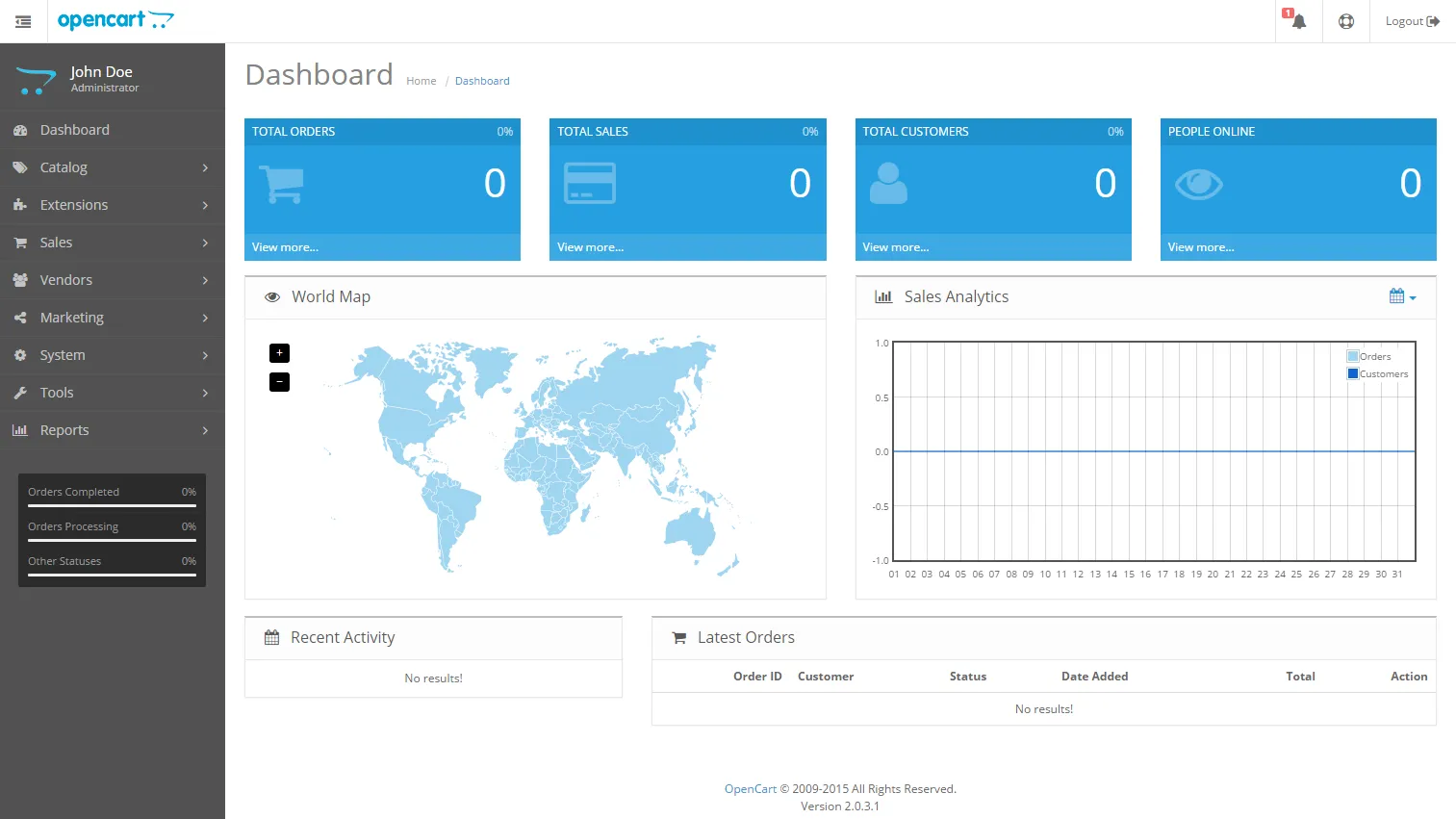
BigCommerce ease of use
In the comparison of OpenCart vs BigCommerce, creating a store on BigCommerce is significantly simpler and can be done in just a few minutes. You only have to complete the following form:
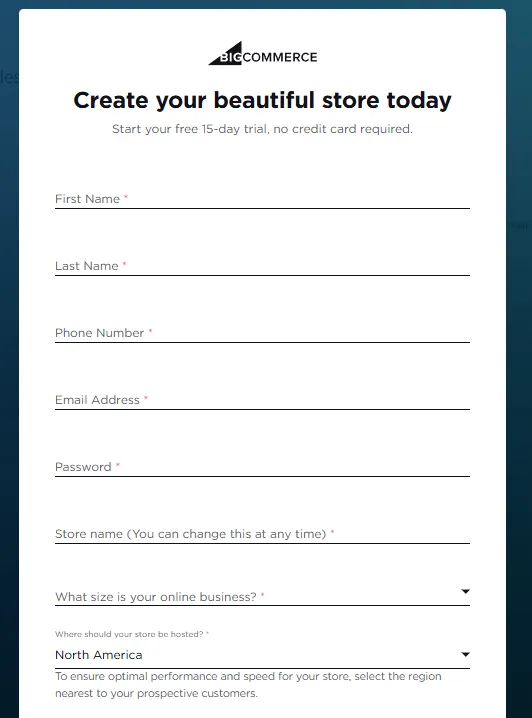
After completing the quick signup process, you’re immediately directed to the BigCommerce dashboard, which has recently been redesigned to improve usability. The new layout is cleaner, with simplified labels, a decluttered sidebar, and a search bar now placed at the top center for faster access.
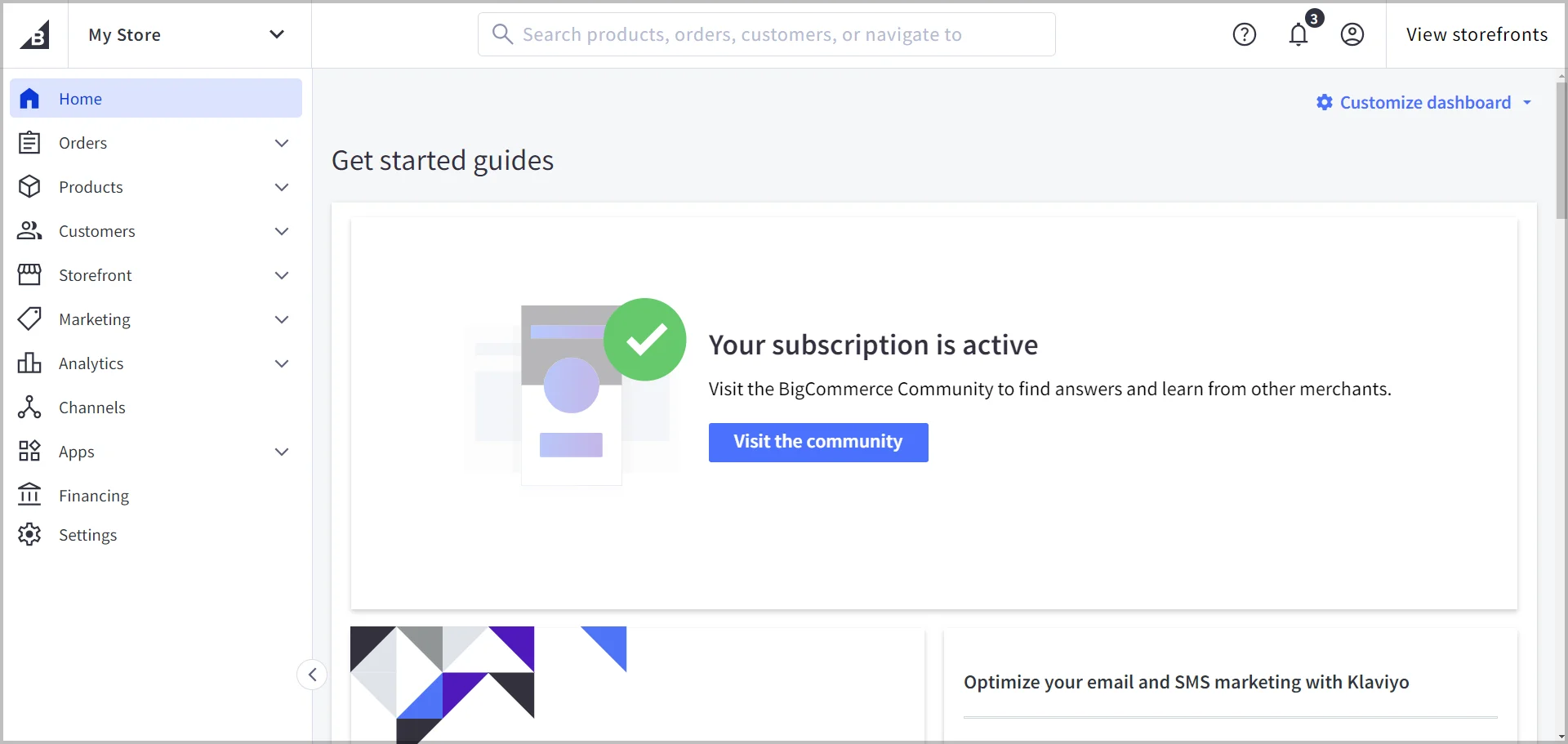
There is also a built-in tutorial that guides you through the four key steps: adding products, configuring shipping, setting up payments, and taxes for launch.
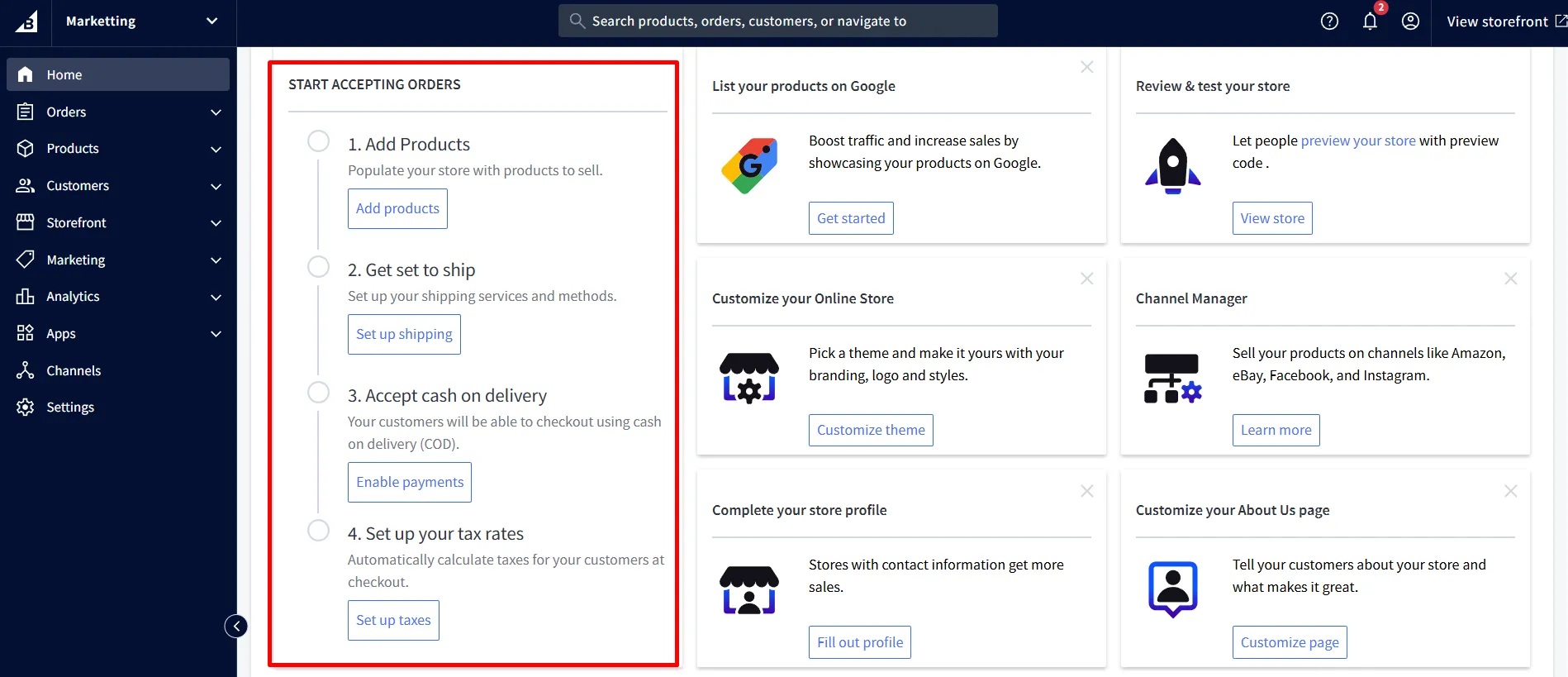
Themes & Customization
The Verdict
Comparing themes and customization between OpenCart vs BigCommerce, BigCommerce clearly wins. Its modern theme library, user-friendly Page Builder, and advanced tools like Stencil and Catalyst give merchants at all levels of customization flexibility.
OpenCart customization
OpenCart comes with a default theme that’s simple, clean, and functional. For merchants who only need a basic storefront, customizing this theme is fairly straightforward. Through the admin panel, you can adjust layout positions, enable or disable modules, manage banners, and update basic content without having to code.
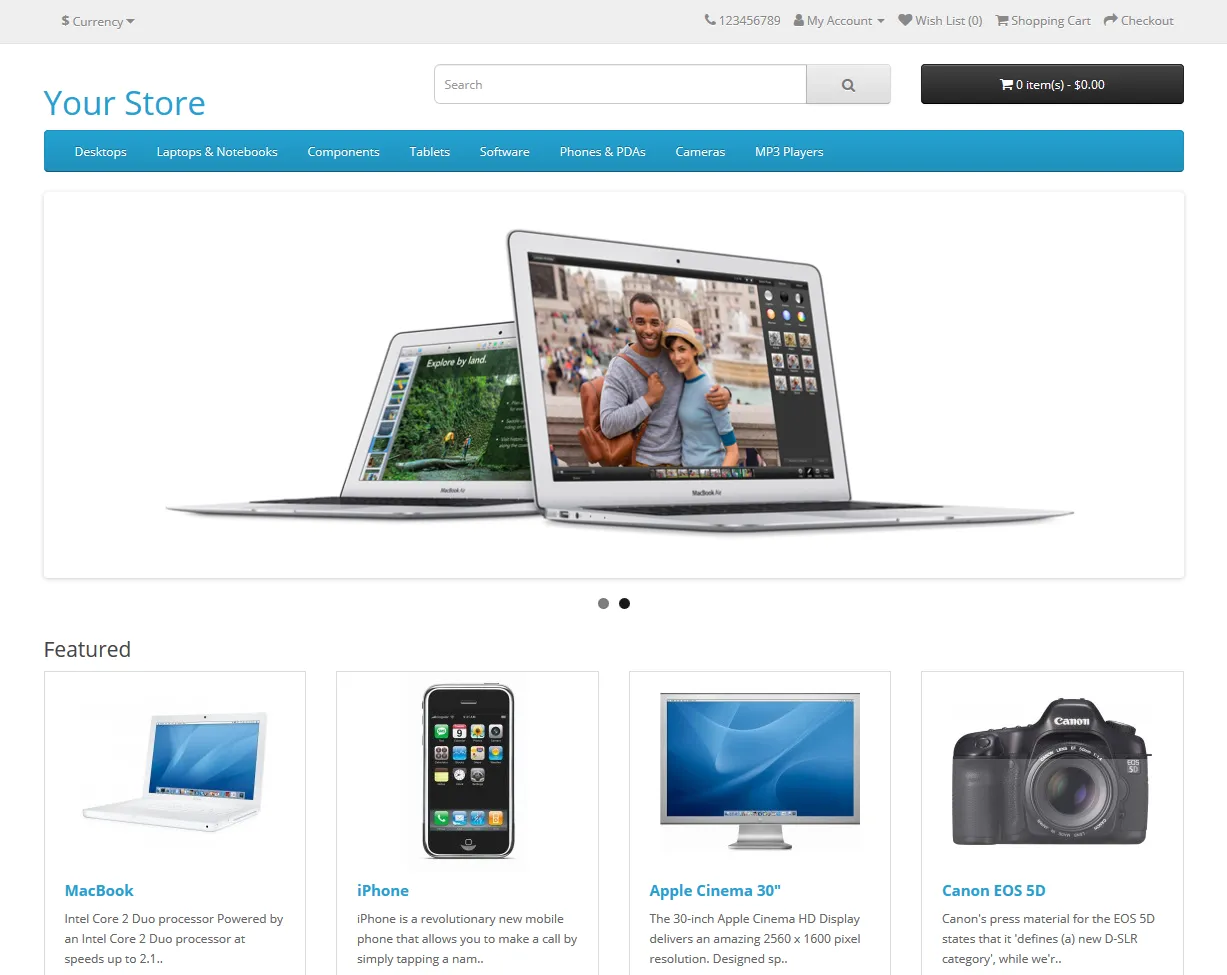
For more advanced customization, you can install a third-party theme. There are hundreds of themes available across OpenCart’s official marketplace and external sites. Many premium themes include additional settings panels or layout tools, but deeper design changes usually require editing the theme’s template files (.twig), CSS, or even PHP. This level of design can be challenging for merchants who lack technical skills or coding experience.
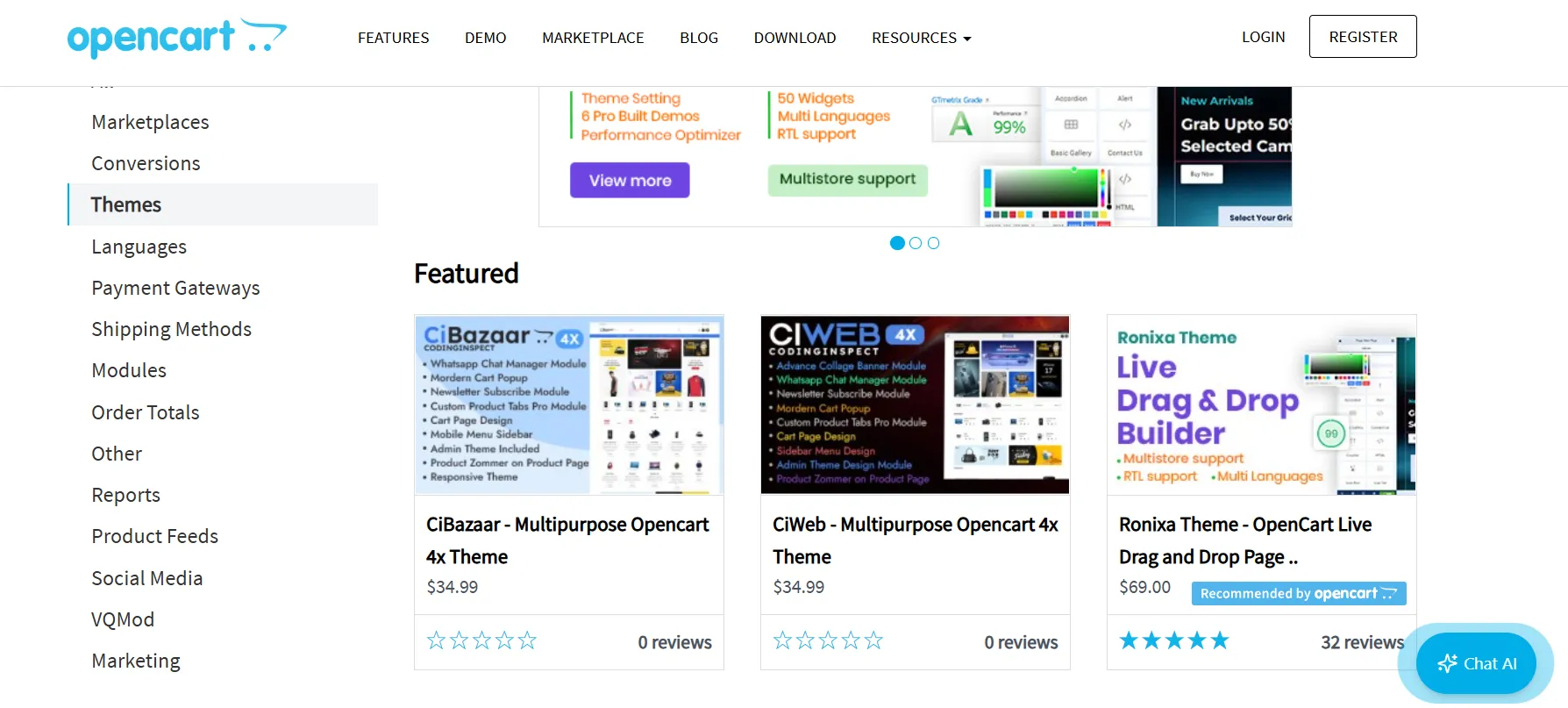
BigCommerce customization
Moving on to BigCommerce, every new store starts with a default theme called Cornerstone Light, a clean and mobile-responsive design that works well for most industries. If you’re looking for something different, you can browse the BigCommerce Theme Marketplace, which offers over 200 professionally designed themes, including both free and premium options.
For customization, BigCommerce includes a built-in Page Builder that lets you make visual edits with no coding. With this tool, you can:
- Drag and drop content blocks like images, banners, and text;
- Adjust page layouts and section spacing;
- Customize colors, fonts, and buttons;
- Preview changes in real-time before publishing.
BigCommerce Enterprise users can go beyond Page Builder. They have access to Stencil CLI for full control over theme code. Additionally, enterprises are also offered Catalyst, a modern storefront framework built on Next.js. It’s designed for faster page loads, headless flexibility, and a more streamlined developer experience.

eCommerce Features
The Verdict
When putting the two platforms, BigCommerce and OpenCart, next to each other, the first one clearly wins this round. Its built-in features are far more comprehensive and require less manual work. Also, they have all the features to support your growth at every stage.
Since you're selling online, the built-in eCommerce features of your platform play a huge role in your day-to-day operations. Below is a head-to-head comparison of how OpenCart vs BigCommerce stack up across core selling functions:
Feature | OpenCart | BigCommerce |
Product catalog & management | - Unlimited products - Basic options (e.g., size, color) without unique SKUs - No native variant inventory tracking - Bulk editing and filtering require third-party extensions | - Unlimited products - Up to 600 SKUs per product and 250 product variants - Native support for variants, inventory, and pricing per SKU - Built-in bulk editing, filtering, and advanced search |
Order & customer management | - Basic order tools included - No built-in returns, segmentation, or order notes - Advanced features require extensions | - Native order management with status updates - Built-in returns and RMA handling - Customer segmentation tools included - Order comments and customer notes supported |
Multi-store capabilities | Multi-store is supported out of the box. You can manage multiple stores from one dashboard. | Requires BigCommerce Enterprise. Each store can be managed separately under one backend. |
Shipping methods | Basic shipping methods included. Advanced rules or real-time rates need paid extensions. | Offers real-time shipping quotes, carrier integrations, and advanced shipping rules natively. |
Payment gateways | Supports 50+ gateways like PayPal, Stripe, and local providers. Some may require manual setup. | Supports 65+ payment gateways with 1-click setup and zero additional transaction fees. |
B2B features | Possible with the right extensions, requires manual setup for quotes, wholesale pricing, etc. | Native B2B suite (for Enterprise) with customer groups, custom pricing, quote management, and more. |
SEO & Marketing Tools
The Verdict
If you’re running a basic or mid-sized store, BigCommerce wins in this category. Its built-in SEO and marketing tools are more than enough for most merchants so you won’t need to rely on third-party apps.
OpenCart SEO & marketing
OpenCart gives you solid control over your store’s SEO, especially if you’re comfortable with technical setups. You can manually configure meta titles, meta descriptions, and SEO-friendly URLs for each product and category.
And, since it is open-source, the platform also allows you to customize elements like robots.txt, sitemaps, and even structured data or FAQ schema. But please be aware that you will need some technical knowledge or developer support.

On the marketing side, OpenCart covers the basics: discount codes, banner ads, and affiliate tracking. But for tools like email marketing, abandoned cart recovery, or loyalty programs, you’ll need to rely on external modules, which can vary in quality and ease of integration.
BigCommerce SEO & marketing
On the other hand, BigCommerce offers a far more streamlined SEO and marketing experience, right out of the box. All stores come with a suite of SEO-friendly features built in, including:
- Customizable, automated SEO-friendly URLs
- Unique URLs to avoid duplicate content
- Rich snippets (ratings, price, availability)
- Automatic 301 redirects and URL rewrites
- Built-in sitemap generation and robots.txt control
- Fast page load times via integrated CDN
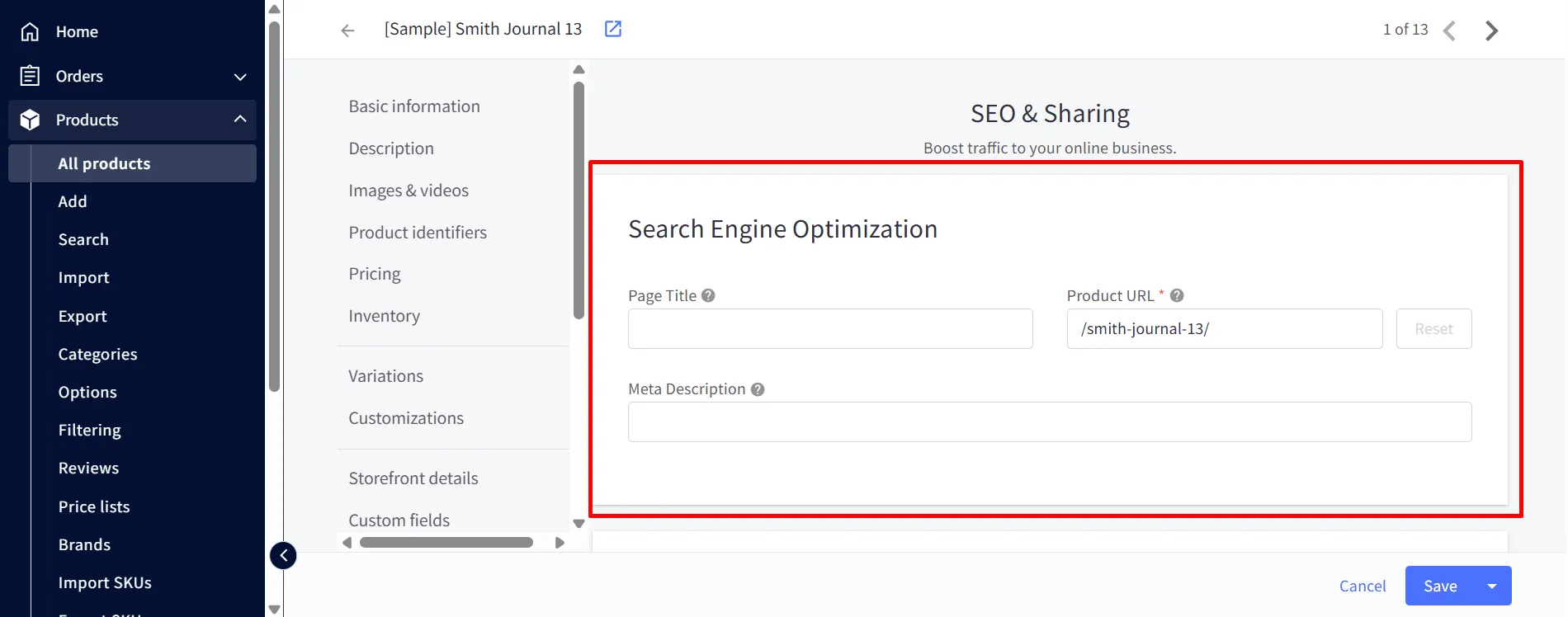
These features are ready to use from day one, with no need for extra apps or configuration. Even better, BigCommerce is one of the few hosted platforms that allows full customization of SEO URLs, a rare flexibility that most SaaS platforms don't offer. This gives you full control over how your product and page URLs appear in search results, without needing developer help or third-party tools.
Marketing tools are also built into the platform. Merchants can create coupon codes, schedule promotions, and connect to platforms like Google Ads, Facebook, and email services without relying on third-party extensions. More advanced tools like abandoned cart saver and customer segmentation become available as you move up to higher-tier plans.
Apps & Integration
The Verdict
In this round, we would give the edge to BigCommerce. It offers fewer apps, but they’re all carefully reviewed and easy to install.
OpenCart integration
OpenCart offers a massive extension marketplace with over 13,000 modules, covering everything from payment gateways and shipping methods to SEO, analytics, and advanced checkout flows. This makes it one of the largest ecosystems among eCommerce platforms.
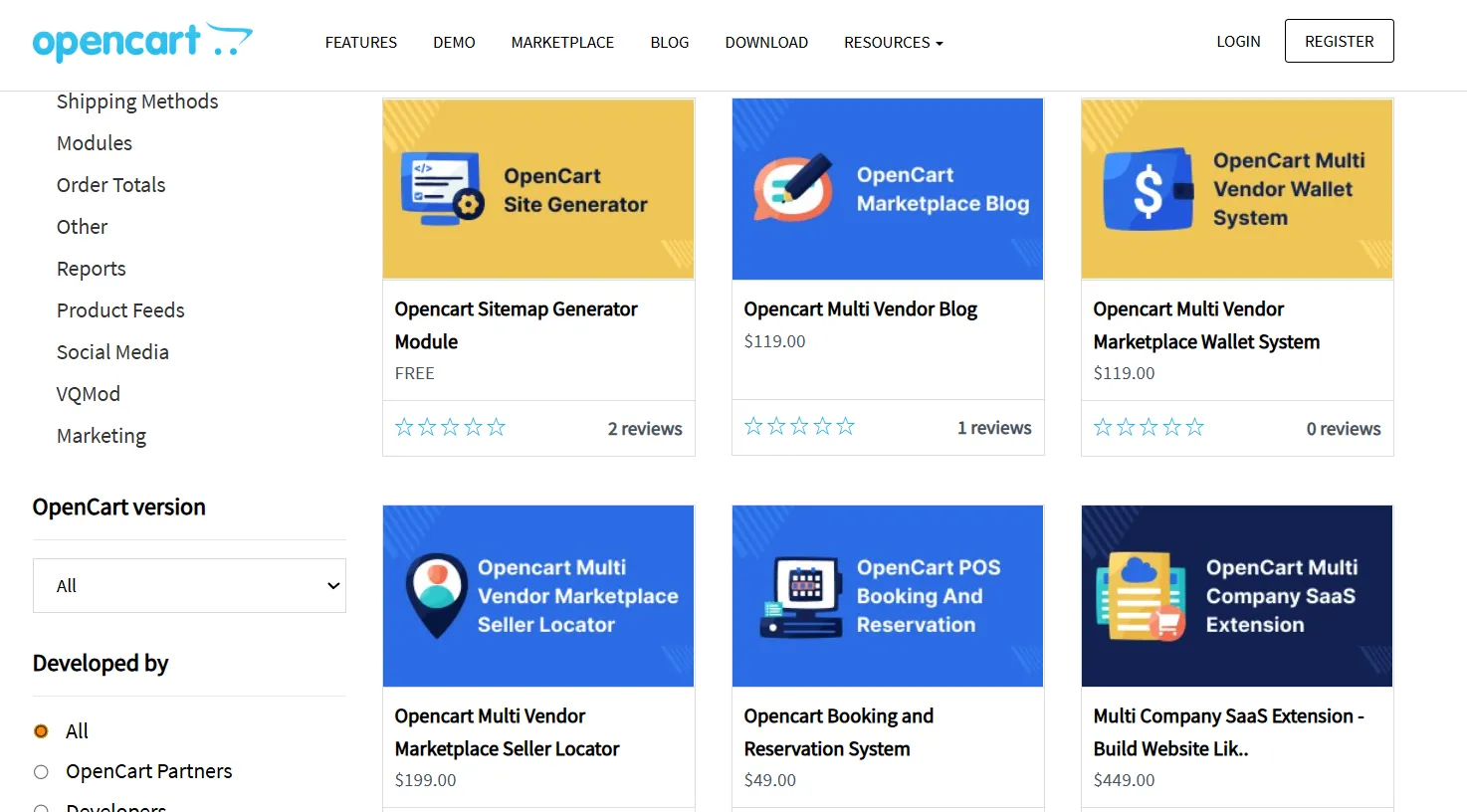
However, it's important to note that OpenCart does not have a deep review process for all extensions submitted to its marketplace, like other hosted platforms. As a result, the quality, security, and long-term support of these extensions can vary significantly. We recommend checking user reviews carefully and downloading extensions from trusted providers or well-known developers to avoid issues down the line.
BigCommerce integration
In the OpenCart vs BigCommerce comparison, BigCommerce offers fewer apps than OpenCart, with just over 1,200 apps available in its official App Marketplace. Rather than focusing on volume, BigCommerce emphasizes quality and reliability by carefully reviewing the apps.

No matter what your business needs are – marketing, shipping, accounting, CRM, ERP, or multi-channel sales – BigCommerce has a trusted app to support it. Many of the most widely used tools, such as Mailchimp, Google Ads, QuickBooks, ShipStation, and Meta integrations, are available and can be installed in just a few clicks.
For Enterprise merchants, BigCommerce offers advanced integration capabilities through its network of technology partners. It also supports headless commerce, allowing businesses to build custom front ends without disrupting the core backend operations.
Security & Compliance
The Verdict
In the debate of OpenCart vs BigCommerce security, BigCommerce is the clear winner. It manages compliance, threat protection, and updates for you, removing the burden from store owners and reducing risk.
OpenCart security
Running your store on an open-source platform like OpenCart means you have to handle security on your own. That includes installing SSL, managing server settings, and applying software patches manually. PCI compliance isn’t guaranteed, so it depends entirely on your hosting setup.
Because of this, many store owners turn to third-party extensions or managed hosting for extra protection. Without those, your store may be at risk, especially if you're not technically experienced.
BigCommerce security
At the same time, security is baked into the BigCommerce platform from day one. With automatic SSL, PCI DSS Level 1 compliance, and 24/7 threat monitoring, it takes the pressure off your team. There’s no need to worry about patches, firewalls, or DDoS protection; these are all handled behind the scenes.
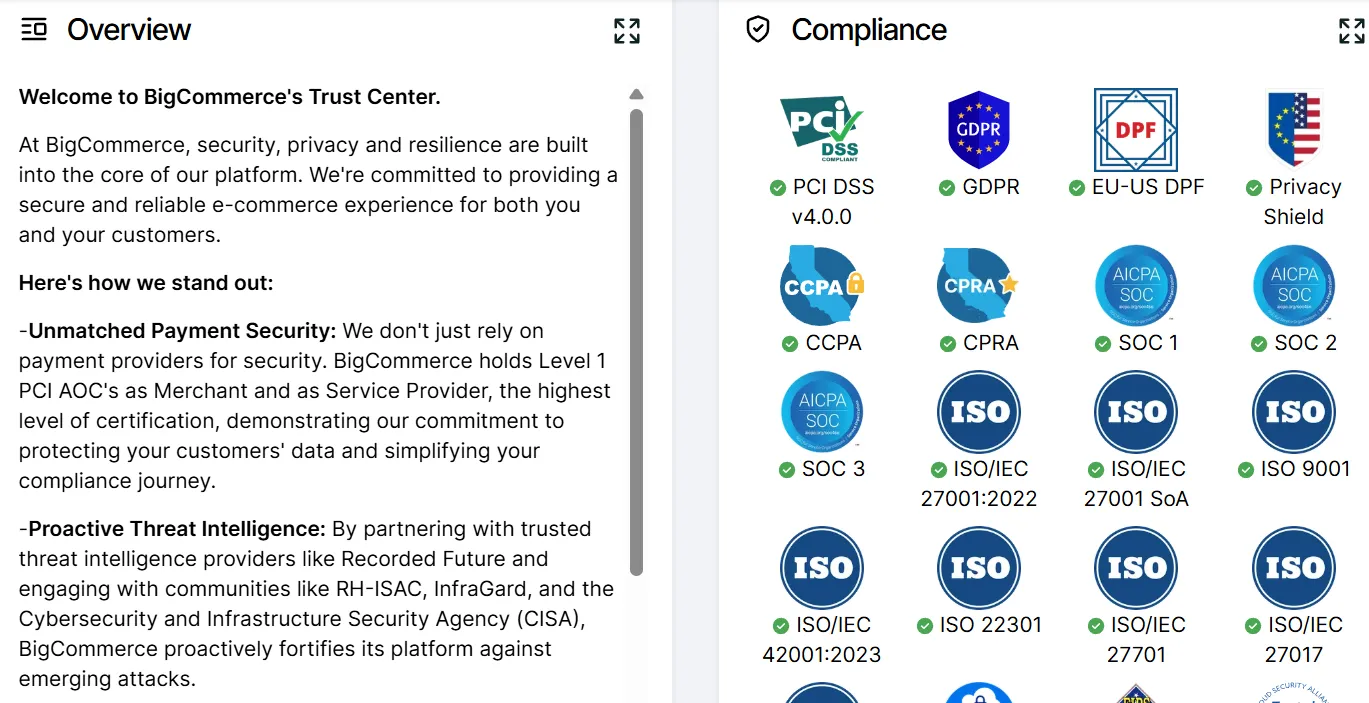
Customer Support
The Verdict
In the OpenCart vs BigCommerce customer support battle, BigCommerce takes the lead with its 24/7 support availability, live chat, phone assistance, and a rich knowledge base. If reliable and responsive support is a priority, you should definitely go for this platform.
OpenCart customer support
OpenCart provides official support via email tickets. Merchants can contact [email protected] daily from 09:30 to 18:30 (HK time). However, response times may be slower compared to hosted platforms.
You can also explore its Help Center, which offers documentation, video tutorials, and blog posts; however, these resources may not always cover advanced or up-to-date use cases. Users also turn to the OpenCart community forum for practical advice from peers.

BigCommerce customer support
In contrast, BigCommerce offers 24/7 support via live chat, phone, and email, even during your free trial. Their agents are known for being responsive and helpful, especially for new merchants. Enterprise customers receive priority support and a dedicated success manager to guide growth.
Beyond that, BigCommerce has a robust Help Center with step-by-step guides, video tutorials, and detailed developer docs. The platform also offers community forums, webinars, and a partner directory for agencies and tech providers.
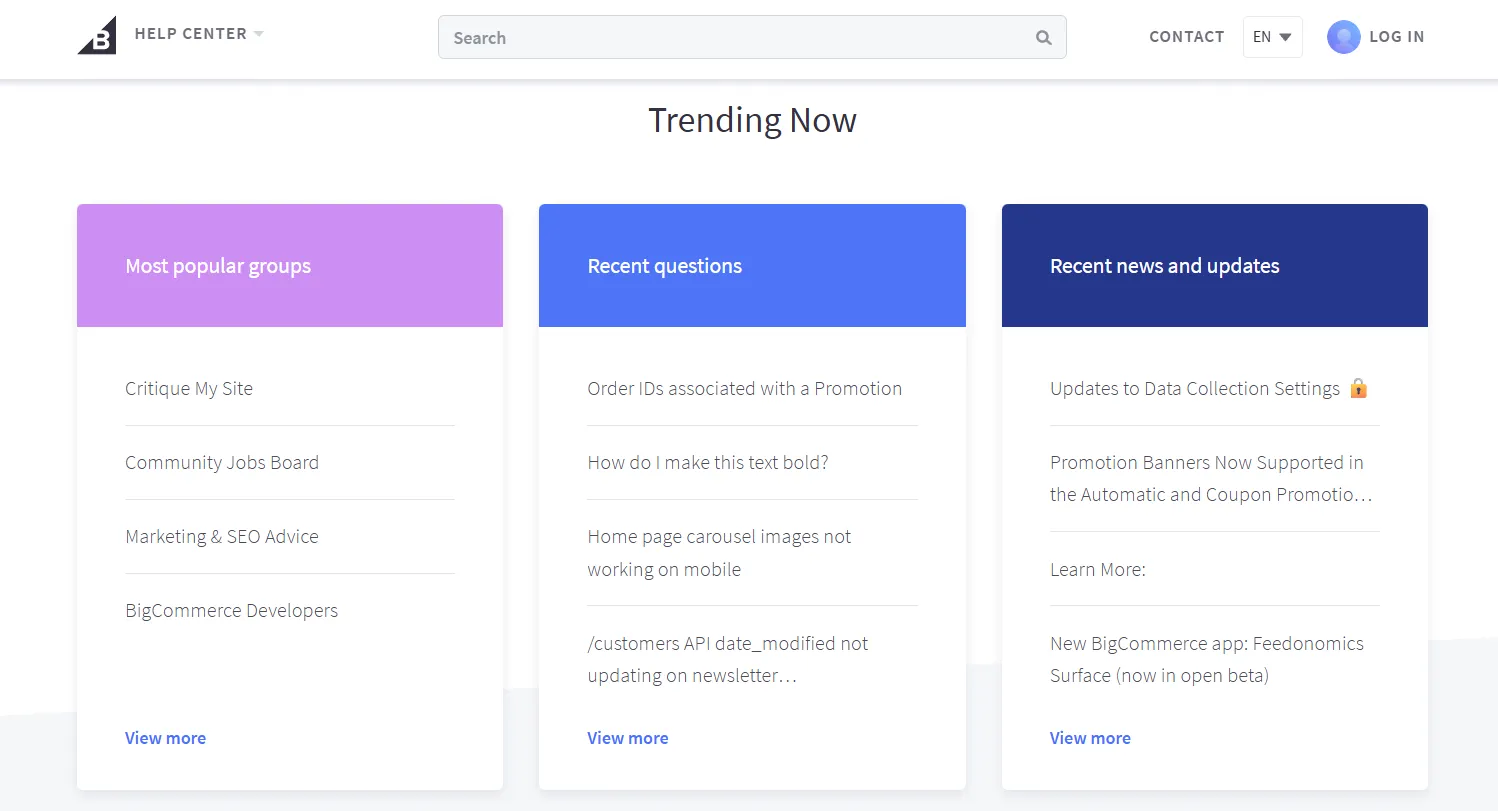
OpenCart vs BigCommerce: Which Platform is Best Suited For You?
After comparing OpenCart vs BigCommerce across all core features, the right choice depends on your needs, technical skills, and business model. Here are the business types that align best with each platform:
OpenCart is a better fit for:
- Tech-savvy entrepreneurs who want full control over their store’s infrastructure.
- Small-to-medium businesses looking for a low-cost, self-hosted solution.
- International sellers who need multi-store or multi-language setups.
- Developers/agencies building custom solutions for clients.
BigCommerce works best for:
- Growing brands that want a platform to scale with them at every growth stage.
- Retailers and wholesalers need strong B2C or B2B functionality.
- Enterprises with complex product catalogs and multi-channel sales goals.
If you’re planning to switch between these two platforms, LitExtension is here to help. Whether you’re moving from OpenCart to BigCommerce or the other way around, our migration service ensures your store data is transferred quickly and securely. With no downtime, expert support, and 100% data integrity, you can focus on growing your business while we handle the heavy lifting.
Seamlessly migrate your store to a more robust place!
LitExtension can safely transfer your data to unlock more growth on the new platform.

OpenCart vs BigCommerce: FAQs
What are the disadvantages of OpenCart?
OpenCart requires technical knowledge to fully unlock its potential. Many essential features depend on third-party extensions, which vary in quality and support. Managing updates, security, and compatibility can also be challenging for non-developers.
What are the disadvantages of BigCommerce?
BigCommerce can be more expensive than other platforms, especially as your revenue grows. Some advanced features, like multi-store support or native B2B tools, are limited to the Enterprise plan, which may not suit smaller budgets.
Is OpenCart better than Shopify?
Based on our OpenCart vs Shopify comparison, Shopify wins in many aspects. It’s easier to use, requires no coding, and handles hosting, security, and support for you. OpenCart offers more control as an open-source platform, but it demands technical skills and more manual setup.
Is BigCommerce good for small business?
Yes, BigCommerce offers a solid feature set even at its entry-level plans. It’s a great choice for small businesses that want powerful tools without needing extra apps, and prefer a hosted solution with built-in support.
Can I sell digital products on BigCommerce?
Absolutely. BigCommerce supports selling digital products like eBooks, music, software, and more. You can upload files, set download limits, and manage delivery, all from the admin panel.
Conclusion
When comparing OpenCart vs BigCommerce, the choice really comes down to how much control you want and how much responsibility you’re willing to take on. Hopefully, this article has helped you get a clearer picture of what to expect from both platforms and which one aligns better with your goals.
If you’re still exploring your options, check out our other eCommerce platform blogs or join the community for peer insights.

